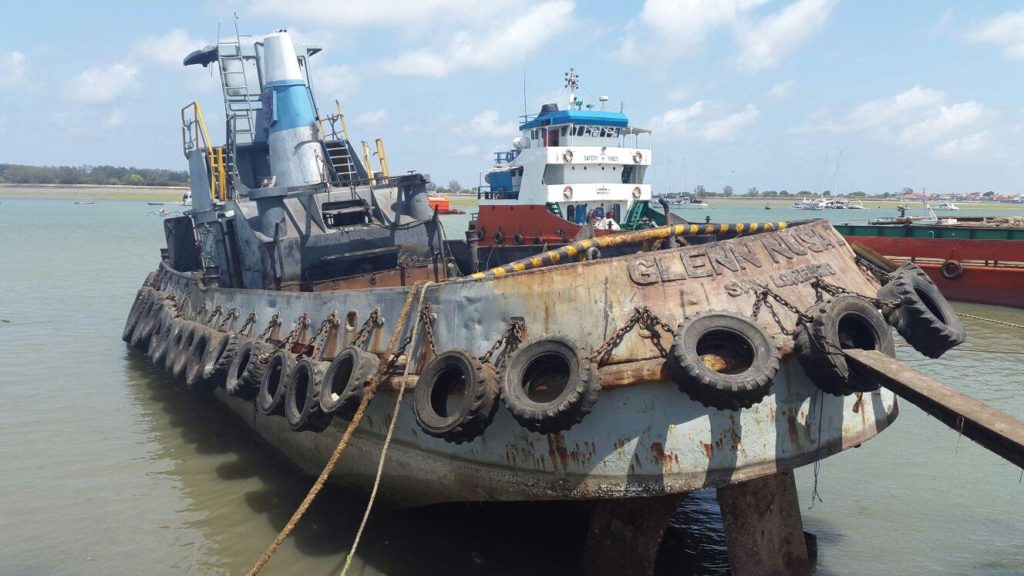PADI Instructor Development Course (IDC) graduates often find it hard to decide which PADI specialty’s they wish to take. Often new instructors focus on the most popular specialties; PADI Enriched Air Specialty Instructor Course and the PADI Deep Diver which of course is a great idea.
We here at the Gili IDC in the Gili Islands, Indonesia often recommend the PADI Wreck Specialty Instructor Course as there are many wrecks scattered across the entire globe and they play an important role in our underwater environment. Another important factor is that during the PADI Wreck Specialty Instructor Training you will learn some interesting and possibly vital procedures involved in penetrating wrecks. Making your courses not only more enjoyable but a lot more educational.
In this article we will explore many of the additional questions that we get asked on a regular basis.
Are there any wrecks around the Gili Islands?
There are a number of different kind of wrecks scattered within our oceans, ranging from small fishing vessels to large military tankers. In fact here in Indonesia there are numerous wrecks. One of the owners of Trawangan Dive was lucky enough to have found our local wreck, the “Japanese Wreck”, which can be accessed in approximately 30 minutes from the beach in front of the Trawangan Dive Centre. The wreck was originally a Japanese patrol boat that sank in the Second World War, it now sits in approximately 45 meters of water and hosts a variety of marine life.

For recreational divers recreational diver’s there is also the Glen Nusa Wreck; The Glen Nusa wreck is a tugboat that was deliberately sunk in 2016 specifically for diving and to be an artificial reef at Shark Point dive site. It sits upright at approximately 30 meters deep with the shallowest point at around 20m; it is a magnet for local marine life and is the perfect site for specialty Wreck training. A third Wreck, The Bounty, is more accessible for Open water divers as it ranges from 7 to 18m in depth. The Bounty was originally a pier extending from neighboring Gili Meno but has been submerged for several years and is now a reef in itself! It is a fantastic site for macro and schooling fish and popular with DSD and Open Water divers. Other wrecks include the USAT Liberty wreck on the neighboring island of Bali, as well as the Kubu wreck. Both can be found in north Bali, approximately 45 minutes by boat. This is why IDC Gili and Trawangan Dive will always recommend potential Instructor Candidates and Divemasters alike to consider taking the Wreck specialty and Instructor specialty courses.
Why are Wrecks so important?
Fundamentally wrecks are mega structures, usually situated in areas of varying currents and areas where nothing would usually be found. As a wreck ages rust will appear and surfaces will change textures adding to the complexity of the structure.
This mega structure allows currents to flow into the wreck and become erratic in their behavior creating a series of eddies and therefore creating a multitude of varied micro habitats. These structures do not only provide a thriving environment for the smaller species, but areas such as the bulk head provide sufficient shelter for larger species such as barracuda and sharks. Other bottom dwelling and threatened species such as nurse, bamboo, and leopard sharks, which often appear to be sleeping, can gain the protection they need. In fact every area the wreck provides a benefit to our marine environment. Even the rope will provide shelter for juvenile fish and protection for many macro species.
What are the hazards and dangers with wreck diving?
Wrecks are usually deep and dark and can contain a lot of silt so visibility can become a problem to a non-experienced diver. Wrecks do not always stand vertically up so disorientation is possible. Divers run a potential risk find that they can’t find the way out of a wreck that they have just penetrated.
These days artificial wrecks are usually pre prepared for diver safety, but more often in natural wrecks there can be sharp edges, metal and glass present. These sharp objects can often cut through the diver’s wetsuit and penetrate the skin.
Other hazards when diving in wrecks are marine injuries; stonefish, sea urchins and fire coral are all common residents on wrecks and can therefore cause injury to divers. Although many wrecks are supposed to be protected and therefore to be out of bounds to fisherman, nets and hooks do occasionally become a hazard when diving.

2 
3 
4
What are the preventions for these hazards and dangers?
Of course the main prevention is to become properly trained to deal with the hazards and dangers when wreck diving. You may have thousands of dives, and hold a technical diving qualification, but that doesn’t necessarily help when diving wrecks. Some principles involved with cave diving may appear similar, but there are some situations that differ enormously. The PADI wreck diving specialty is a fantastic course to allow you to confidently explore, within recreational limits, the Oceans many wrecks.
Firstly your equipment configuration should be closely observed. Knowing where everything is on your own equipment and on those diving with you. Streamlining must also be closely observed during a wreck dive. Certain lifesaving equipment may be duplicated for safety reasons, thus many divers will carry two knives, two torches and two underwater signaling devices.
It is also important to consider the wreck itself in respect of your chosen equipment configuration; for example In a very large wreck it may be more suitable to use an alternative configuration such as dual tanks, or in a wreck with very small penetration points it may be an idea to consider side mount.
When penetrating a wreck, divers must consider how they will come back especially in a zero visibility situation. Never penetrate a wreck without a line and always be trained to use the lines.
Planning is also vital when it comes to wreck diving. Special considerations must be discussed with your buddy in terms of signals and potential out of air situations. Also it is important that you and your buddy are in constant communication at a suitable distance from each other.
What is involved in the PADI Wreck Diving Specialty?
PADI offers the Wreck Diving Speciality Course. The course is available to those who have completed the adventure diver program or similar qualification. Wreck penetration-training dives are limited to within the light zone and within 40 meters/130 feet from the surface, vertical and horizontal distance included. If the wreck used for training is located in deep water (over 18 meters/60 feet), the Deep Diver rating is recommended as a prerequisite for the Wreck Diver program.
The practical portion of the course is 4 dives on wrecks. These dives include the planning, organization, procedures, techniques, problems and hazards of wreck diving; As well as the preparation and use of lights, air supplies, special equipment, penetration lines and reels. The course also covers limited-visibility diving techniques and emergency procedures.
You will learn the techniques for diving and exploring shipwrecks, and how to avoid the common hazards outlines in this article. The course will teach you how to research the background of the wrecks you wish to dive, techniques for entering and exiting the chosen wreck and the equipment considerations for the potential dive. During the course you will gain experience of organizing, planning and making four separate wreck dives under the supervision of your Instructor
For Instructors, you can opt to become a PADI Wreck Diver Speciality Instructor. There are two ways to achieve this rating; the preferred option is to take the PADI Specialty Instructor Course with a PADI Course Director. The Specialty Instructor Courses provide valuable teaching tips for meeting the requirements of the course and allows Instructors to become confident in teaching the wreck specialty. The second option is to have at least 25 PADI certifications already under your name and to use your own wreck diving experience to apply to PADI directly. PADI however will only consider applicants who have over 20 logged wreck dives. There are many wrecks around the world and the likely hood is that instructors will be travelling to a place where there are not only an abundance of wrecks, but also no short supply of people wishing to take the wreck specialty. This will only increase their employment options and provide them with more earning potential.
So, all in all the wreck diving Specialty Instructor course is a fantastic course to take and works especially well when you combine it with the Deep and Nitrox Specialty as many wrecks can be located at below 25 meters and may require a longer bottom time to fully explore. In turn this can be a great combination to offer to recreational divers looking to try new things. Of course before taking specialty Instructor training you will need to take the PADI Instructor Development Course and become an Open Water Scuba Instructor.
The PADI IDC Indonesia Scuba Diving Instructor Development Course in the Gili Islands is entirely conducted by Award Winning, Industry Leading Multiple Platinum PADI Course Director Holly Macleod and takes place at the only ever 5 Star PADI IDC Career Development Center (CDC) to have ever been established on the island of Gili Trawangan.
Holly has specifically designed an IDC training program that is based on a wealth of industry experience teaching all levels of divers from entry level Discover Scuba Diving (DSD) participants to those preparing to become PADI Course Directors.
Having Issued over 3000 Instructor level certifications in the Gili Islands alone, being awarded the Platinum Frequent Trainer Award for 7 years running and having spent the last 17 years teaching PADI Courses & Programs in variety of different global diving destinations including Honduras, Thailand, Australia, UK, Malaysia, Philippines, Indonesia and Singapore; Holly has the level of experience to assist professional divers in developing skills, knowledge and confidence to be highly successful and is the perfect person to consult when making the transition into a new career knowing exactly what is expected from new instructors and of course what new scuba diving instructors should expect from the diving industry.
Over the last decade Instructor training with Holly has become the number one choice for professional divers looking to teach others and the PADI IDC Gili Islands Reviews can offer more of an insight into the reasons why. All of the latest news and updates can be found by simply checking out the Gili IDC Instagram Page.

